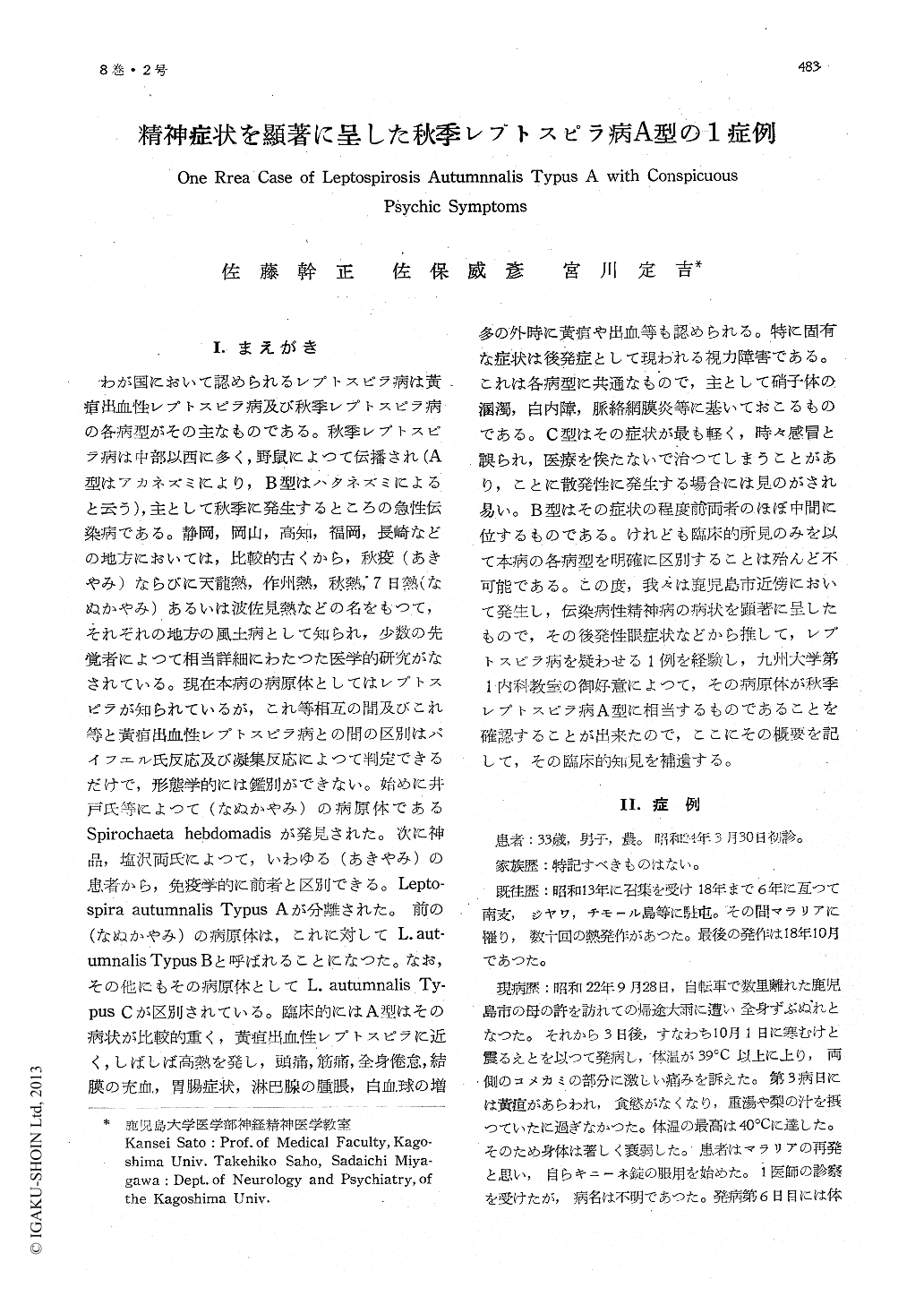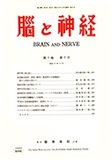Japanese
English
- 有料閲覧
- Abstract 文献概要
- 1ページ目 Look Inside
I.まえがき
わが国において認められるレプトスピラ病は黄疽出血性レプトスピラ病及び秋季レプトスピラ病の各病型がその主なものである。秋季レプトスピラ病は中部以西に多く,野鼠によつて伝播され(A型はアカネズミにより,B型はハタネズミによると云う),主として秋季に発生するところの急性伝染病である。静岡,岡山,高知,福岡,長崎などの地方においては,比較的古くから,秋疫(あきやみ)ならびに天龍熱,作州熱,秋熱,7日熱(なぬかやみ)あるいは波佐見熱などの名をもつて,それぞれの地方の風土病として知られ,少数の先覚者によつて相当詳細にわたつた医学的研究がなされている。現在本病の病原体としてはレプトスピラが知られているが,これ等相互の間及びこれ等と黄疽出血性レプトスピラ病との間の区別はパイフエル氏反応及び凝集反応によつて判定できるだけで,形態学的には鑑別ができない。始めに井戸氏等によつて(なぬかやみ)の病原体であるSpirochaeta hebdomadisが発見された。次に神品,塩沢両氏によつて,いわゆる(あきやみ)の患者から,免疫学的に前者と区別できる。Lepto-spira autumnalis Typus Aが分離された。前の(なぬかやみ)の病原体は,これに対してL.aut-umnalis Typus Bと呼ばれることになつた。なお,その他にもその病原体としてL.autUmnalis Ty-pus Cが区別されている。臨床的にはA型はその病状が比較的重く,黄疽出血性レプトスピラに近く,しばしば高熱を発し,頭痛,筋痛,全身倦怠,結膜の充血,胃腸症状,淋巴腺の腫脹,白血球の増多の外時に黄疽や出血等も認められる。特に固有な症状は後発症として現われる視力障害である。これは各病型に共通なもので,主として硝子体の溷濁,白内障,脈絡綱膜炎等に基いておこるものである。C型はその症状が最も軽く,時々感冒と誤られ,医療を俟たないで治つてしまうことがあり,ことに散発性に発生する場合には見のがされ易い。B型はその症状の程度前両者のほぼ中間に位するものである。けれども臨床的所見のみを以て本病の各病型を明確に区別することは殆んど不可能である。この度,我々は鹿児島市近傍において発生し,伝染病性精神病の病状を顕著に呈したもので,その後発性眼症状などから推して,レプトスピラ病を疑わせる1例を経験し,九州大学第1内科教室の御好意によつて,その病原体が秋季レプトスピラ病A型に相当するものであることを確認することが出来たので,ここにその概要を記して,その臨床的知見を補遺する。
The patient, a 33-year-old male, had a cycloid character. We first examined him on March, 30, 1949. He said that on Sept. 28, 1947 he was drenched to the skin by heavy rain on his way home from the city Kagoshima, a distance of about 20 kilometer by bicycle. The disease began subddenly on Oct. 1, with chills and a violent headache in the temples, followed by a rising temperature of about 39℃., which after-wards reached about 40℃. On the third day, appeared jaundice and he had dull appetite, being able to take only a small quantity of rice soup and fruit juice. Therefore, he grew very weak.
On the sixth day the fever fell. From this time on, his consciousness became cloudy, his mood was elated and he sometimes sung very loudly and sometimes delivered speeches. There occured also various sorts of hallucinations, and above all, visual and haptic disorders. Every evening these symptoms became especially remarkable (collapse delirium)
Such a syndrome disappeared after about a week. His appeite increased forthwith and the state of nutrition became better. On the contrary, after this period, there occured visual disturbances and such a high grade amnesia and disorientation, that he could not return home even from his own field, where he went to inspect it (postinfectious Korsakow's psych-osis).
He complained also of sleeplessness and a hypochondriac feeling.
By ophthalmological examination we found cataracta choreoretinitis, opasitas corporis vitrei and cataracta incipiens. After such a special sort of pathological changes in the eye, we suspected a leptospirosis, and we could prove in blood serum of the patient a positive bacte-riolytic phenomenon to Leptospira autumnalis Typus A, up to 2560-fold dilution, even 3 years after the acute symptoms of the disease disap-peared. While to L. icterohaemorrhagica was positive up to merely 80-fold dilution and to L. autumnalis Typus B and C were negative.
He recovered from the above mentioned con-dition gradually with the lapse of time. But he suffered anew from the depressive phase of manic-depressive psychosis due to home affairs, and received hospital treatment from March 9 to May 23, 1931. The insomnia and hypochon-driac feeling- which he had presented before should have been prodromal symptoms of the latter.

Copyright © 1956, Igaku-Shoin Ltd. All rights reserved.


